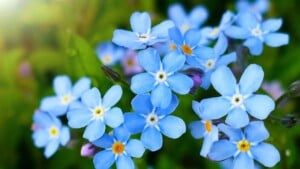Now that our lawns, garden plots, and everything else is covered in a blanket of snow — a blank slate of sorts — we start to think about how we want them to look next spring and summer. What we’re picturing during this dose of dead-of-winter-in-late-fall weather is grass, not the kind that comes in rolled strips and requires mowing and lots of water. We’re thinking of bold, unique grasses that require far less watering and no mowing whatsoever (though we might be trimming them back in the late fall or winter).
Why are we thinking grasses? For the reasons already stated. They need less water than a lawn and less care. They’re much more adaptable to organic growing without chemical fertilizers.

LOW MAINTENANCE
Grasses & Flowers
Combines native grasses with a beautiful selection of drought-tolerant plants.
$17.95Learn morePerfect for backyards, road ditches and golf course roughs! This drought-tolerant mixture combines several varieties of native grasses with a beautiful selection of both annual and perennial wildflowers. Remains green through late fall and will grow to a mature height of 6 to 12 inches — mow once or twice a year, if at all!
But the main reason we can’t get them off our mind is their beauty. We’ve spent time in what remains of the tall grass prairies in Iowa and in the Flint Hills of Kansas. We’ve walked the short grass prairies we have in Montana that spread north to Canada and south to New Mexico. The vision of those grasses moving in the wind — we’ve all seen this — looks like waves at sea. And the diversity of plants in what looks like an unending sea of grass gave us images we can’t forget. Blends of tall bluestem and Indian grasses in which tiny pockets of purple violets and cone flowers, yellow goldenrod and other flowering forbs created worlds within worlds. It’s this graceful and textured landscape that has us thinking of how we might recreate these effects in our modest spaces.
When we create water-wise xeriscapes, we move our yards closer to nature. That’s one of the first clues we can take when planning the use of grasses around our homes. What grasses are native to our region? Answer this question and you’ve taken care of all the hardiness issues — water, tolerance to heat and cold, soil conditions — that grasses will face. Most grasses, including ornamental grasses (of which some, like sedges, aren’t true grasses), are hardy in a broad range of zones, most down to zone 4 and some to even zone 3.
We’ve written before about replacing lawns with native grasses and other cover crops. But what we want to do this time around is mimic the mix of grasses and the flowering plants they harbor in the prairie. And we’re hoping to mix ornamentals that aren’t native –but are still hardy — in the mix. Like much of gardening, we’re working from imagination. Trial and error will tell if the mix of plants we see with our mind’s eye will look as good and grow as well as we might think once the growing season returns and we get them in the ground.
What are we seeing? We’re thinking low growing grasses and sedges like blue grama grass and clumps of siskiyou blue (Festuca idahoensis) set in front of tall, accent grasses mixed in with silky Mexican feather grass. We’ve already ruled out giant miscanthus — a plant with promising bio fuel possibilities — because it’s just too large and a bit unsightly near the ground. We’re also considering annuals, like prince elephant grass, because of its showy color, even if it requires more water than most and dies back with the first frost (we’ve heard that if your growing season is long enough it will self-sow). And we’re also considering showcasing some smaller growing clump grasses in pots, like the azure blue oat grass that grows well at high altitudes.
As you might tell, our experience growing grasses, especially ornamentals, is still rather limited. Of course, that’s where the fun in gardening lies: learning how to grow new plants as you shape landscapes and bring what you’ve imagined to life. I’m sure many readers have integrated native and ornamental grasses into their landscape. What can you teach us?












